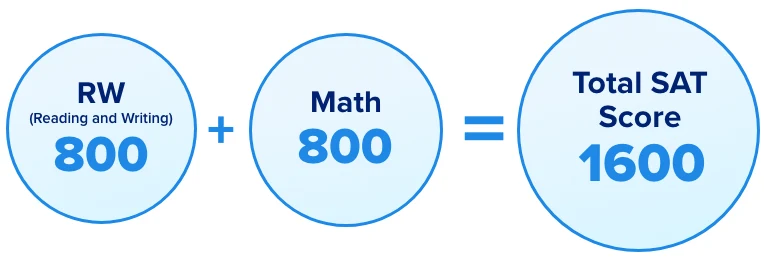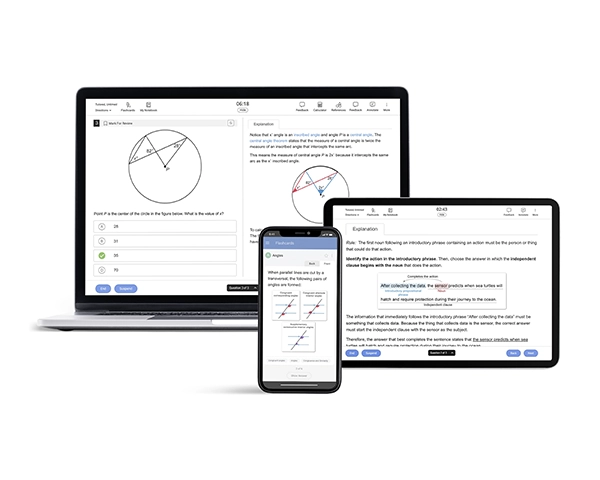What Is the SAT and Why Is It Important?
The SAT® (Scholastic Assessment Test), also known as the SAT exam or SAT assessment test, is a standardized college entrance test administered by the College Board®. It measures readiness for higher education by testing key skills in reading, writing, and math, areas that show how well you can analyze, reason, and apply knowledge to real-world academic challenges.
The SAT test provides a consistent, fair benchmark for evaluating students from different schools and grading systems. It helps colleges compare applicants objectively, ensuring every student is assessed on the same scale of academic ability and reasoning.
Although many institutions now follow test-optional policies, a strong SAT score continues to add value to your college applications. It demonstrates your preparedness for college coursework, enhances your eligibility for merit-based scholarships, and helps you stand out in competitive admissions.
What Does SAT Stand For? (History & Meaning)
If you’ve ever wondered “What is the SAT test?” or “What does SAT stand for?”, the answer lies in its evolution. The SAT stands for Scholastic Assessment Test, though it was first introduced in 1926 as the Scholastic Aptitude Test. The name change reflected a shift from measuring innate aptitude to assessing learned knowledge and reasoning skills.
Over the decades, the SAT has undergone several revisions to align with modern education and college-readiness standards. Today, it’s a digital, adaptive test that provides a faster, more personalized assessment of your academic strengths. The College Board, which conducts the SAT, continues to refine the exam to ensure it remains an equitable and reliable benchmark for global college admissions. You can learn about the key changes in the digital SAT to understand what’s new in the 2026 SAT exam format.
Why Students Take the SAT
Students take the SAT exam to demonstrate their college readiness and strengthen their applications to competitive universities. A high SAT score can help you:
- Stand out in competitive college admissions
- Qualify for merit-based scholarships and financial aid
- Compensate for a lower GPA or limited extracurricular profile
- Meet university placement or honors program requirements
Additionally, the SAT test provides a standardized comparison for international applicants, allowing colleges to evaluate students from diverse academic systems fairly. Taking the SAT also opens opportunities for global study programs and selective U.S. scholarships that specifically consider SAT results.
Who Can Take the SAT and How to Register
The SAT exam is open to all high school students who want to pursue undergraduate studies in the U.S. or other countries that accept SAT scores. There are no strict eligibility criteria based on age or education level, but students usually take the test between grades 11 and 12, when they’ve covered most of the required math and language concepts.
SAT Eligibility Requirements
The College Board does not impose an age limit or academic requirement for the SAT test. However, most students take it during their junior or senior year of high school to align with college application timelines. Younger students may also appear for the exam if they’re ready academically.
International students are equally eligible to take the SAT exam. The only requirements are a valid passport or acceptable ID and completion of the online registration process before the deadline.
SAT Registration Process and Fees
Students can register for the SAT exam online through the College Board website. The process includes:
- Creating a College Board account
- Choosing your preferred SAT test date and testing center
- Uploading a photo ID
- Paying the SAT registration fee
As of 2025, the SAT registration fee is $68 for U.S. test-takers, with an additional $43 international fee for students testing outside the United States. Fee waivers are available for eligible students who meet income-based criteria, ensuring the SAT remains accessible to everyone.
If you’re an international student, the process is similar but includes selecting an authorized test center in your country and verifying your ID requirements. To learn more, check SAT registration and eligibility for international students.
When Is the SAT Held And How Often Can You Take It?
The SAT exam is offered multiple times a year, allowing students to choose test dates that best fit their academic schedule and college application timeline. Whether you’re taking the SAT for the first time or planning a retake to improve your score, understanding the SAT test schedule helps you plan your preparation more strategically. The College Board releases updated SAT test dates and registration deadlines well in advance, giving you enough time to register and prepare confidently.
SAT Test Dates
The SAT exam is conducted seven times a year; in March, May, June, August, October, November, and December. Students outside the United States may have slightly different testing schedules based on regional availability. You can always check the most up-to-date SAT test dates and registration deadlines on the College Board website to plan your preparation timeline.
Ideal Time to Take the SAT
Most students take the SAT test for the first time during the spring of their junior year, allowing enough time to retake it in the fall if needed. Taking the PSAT/NMSQT in earlier grades helps build familiarity with the format and pacing. There’s no limit to how many times you can attempt the SAT, and many students use superscoring, combining their highest section scores from multiple attempts, to strengthen college applications.
Which Colleges Accept the SAT?
The SAT is accepted by thousands of colleges and universities in the United States and around the world. Most 4-year U.S. institutions either require SAT scores or consider them as part of a test-optional admissions process, where submitting strong SAT results can still boost your application. Many international universities in Canada, the UK, Singapore, Europe, and the Middle East also accept SAT scores for undergraduate admissions. It’s important to check each college’s admissions page to confirm whether they are test-required, test-optional, or test-blind and to understand how SAT scores factor into scholarships or placement decisions. For more details, see our guide on colleges that accept SAT scores.
SAT Format and Sections Explained (Digital SAT)
The SAT exam format was redesigned to make the test more streamlined, efficient, and adaptive to each student’s performance level. The Digital SAT, administered through the Bluebook™ testing app, includes 2 main sections: Reading and Writing (RW) and Math, each divided into 2 timed modules. The following table summarizes the number of questions and the time allotted for each section on the digital SAT:
| SAT | ||
|---|---|---|
| Component Test | No. of Questions | Time per Test |
| Reading & Writing (RW) | 54 | 1 hour 4 minutes |
| Math | 44 | 1 hour 10 minutes |
| Total | 98 | 2 hours 14 minutes |
This adaptive design adjusts question difficulty based on your performance in the first module, offering a more personalized experience and accurate measure of your abilities. The SAT exam pattern assesses a range of critical academic skills that reflect your college readiness and mastery of high school coursework. Below is a closer look at what each section includes.
SAT Reading and Writing Section (RW)
The RW section focuses on comprehension, grammar, vocabulary, and rhetorical skills. It consists of two modules with 27 questions each, completed in 32 minutes per module.
Instead of long reading passages, the digital SAT now includes short, standalone texts followed by one question each, testing your ability to analyze meaning quickly.
You’ll be tested on:
- Understanding main ideas and tone
- Vocabulary in context
- Sentence structure, cohesion, and logical flow
- Text structure and purpose
- Recognizing grammar and punctuation errors
For a complete breakdown of topics, see what’s tested in the SAT Reading and Writing section
SAT Math Section
The SAT Math section evaluates your quantitative reasoning and problem-solving skills. It’s also split into two adaptive modules with 22 questions each, to be completed in 35 minutes per module. Topics include:
- Algebra and linear equations
- Advanced math and functions
- Problem-solving and data analysis
- Geometry and trigonometry basics
You can use a calculator for all math questions. The Bluebook app includes a built-in Desmos calculator, but you may also bring an approved device. See which calculators are allowed for the SAT Math test.
SAT Test Duration and Question Breakdown
The SAT exam lasts approximately 2 hours and 14 minutes, divided evenly between the Reading and Writing and Math sections. Each section includes 2 timed modules that adapt to your performance.
During the test, you’ll have:
- A short break between sections
- More time per question compared to the ACT®, allowing deeper reasoning
- Questions that emphasize analysis and application rather than rote memorization
This streamlined format makes the digital SAT less stressful while helping colleges accurately assess your academic strengths and problem-solving skills.
How Is the SAT Scored and What Is a Good Score?
The SAT is scored on a 400–1600 scale, with each section contributing up to 800 points, and understanding how raw scores convert to scaled scores helps you interpret your performance accurately. In short,
Raw-to-Scaled Scoring (400–1600)
Each correct answer adds to your raw score, which is then converted into a scaled score through a statistical process to account for test difficulty. The table below shows the score distribution for the SAT:
| Scoring Section | No. of Questions | Total Raw Score | Scaled Score |
|---|---|---|---|
| Reading & Writing | 54 | 54 | 800 |
| Math | 44 | 44 | 800 |
| Total Scaled Score | 1600 | ||
Each correct answer adds to your raw score, which is then converted into a scaled score through a statistical process to account for test difficulty. A good SAT score depends on your target colleges. For most competitive universities, scoring above 1300 (top 10–15%) can significantly enhance your application.
If you’re wondering what qualifies as a strong SAT score, see our detailed guide on good and bad digital SAT scores to understand how your results compare with college expectations.
Learn more about the SAT test format and review our guide to the SAT syllabus.
Superscoring and Score Reports
Many colleges use SAT superscoring, which combines your highest section scores from multiple test attempts to create your best possible composite score. This means you can improve your overall result by retaking the SAT and focusing on one section at a time.
You’ll typically receive your SAT score report about two weeks after test day. The report includes:
- Your total and section scores
- Percentile ranks comparing your performance with other test-takers
- Subscores showing strengths in specific skill areas
Explore our comprehensive SAT study guide for tips on how to prepare effectively and what to focus on.
Is the SAT Hard? How to Prepare Effectively
Many students often ask, “Is the SAT hard?” The truth is, the SAT exam difficulty depends on your strengths, preparation, and mindset. The test evaluates your reading, writing, math, and analytical skills to measure how ready you are for college-level work.
Common Challenges and Study Tips
While the SAT test can seem challenging at first, consistent practice and a strong study plan make it manageable. Here are some of the most common difficulties students face and how to overcome them:
- Lack of Study Schedule: Balancing SAT preparation with schoolwork can be tough. Without a clear plan, it’s easy to fall behind. A dedicated, structured SAT study plan is essential to stay consistent.
- Time Constraints: Even though the SAT allows more time per question than the ACT, it’s still a timed exam. Strong time management skills are crucial to completing each section effectively.
- Challenging Reading and Writing Section: Many students find this section more difficult than Math. It requires analyzing multiple short passages from various genres and answering questions quickly and accurately.
- Study Tip: Read short news articles or editorials daily and summarize their main idea and tone, this builds critical reading speed and comprehension naturally.
So, how hard is the SAT test really? It’s as difficult as your preparation makes it. With regular practice, smart time management, and a focus on your weak areas, you can master the test.
The SAT is one of the most crucial tests influencing your college admission journey. Plan ahead, stay consistent, and work toward your target score with focus and confidence. If you are looking for a premium SAT practice test that offers detailed answer explanations and real SAT-style questions, check out our SAT Prep Course. Our SAT practice tests and performance analytics show you exactly how you compare to other students preparing for the exam.
SAT for International Students
The SAT exam is a global standard, available to students worldwide who wish to apply to colleges in the United States or other international universities that accept SAT scores. Whether you take the test in New York, London, or Mumbai, the structure, format, and scoring remain the same, ensuring a fair comparison for all applicants regardless of location.
International students must register online through the College Board website. The process involves selecting an authorized test center in your region and paying the standard registration fee plus an additional international regional fee (approx. $43). Because testing centers outside the US often have limited capacity, seats fill up quickly, so we highly recommend registering months in advance to secure your preferred date and location. For step-by-step guidance, review SAT registration and eligibility for international students.
Frequently Asked Questions (FAQs)
References
- The Digital SAT® Suite of Assessments Specifications Overview. (n.d.). satsuite.collegeboard.org. Retrieved from https://satsuite.collegeboard.org/media/pdf/digital-sat-test-spec-overview.pdf
- When Should You Take the SAT? (December 18, 2023). collegeboard.org. Retrieved from https://blog.collegeboard.org/when-should-you-take-the-sat
- What’s the Difference between the SAT and the PSAT-Related Assessments? (March 13, 2024). collegeboard.org. Retrieved from https://blog.collegeboard.org/difference-between-sat-and-psat
- What is Test Optional?. (n.d.). collegeboard.org. Retrieved from https://bigfuture.collegeboard.org/plan-for-college/applying-to-college/tests/8-things-to-know-about-how-colleges-use-admission-tests
- What's on the SAT. (n.d.). collegeboard.org. Retrieved from https://satsuite.collegeboard.org/sat/whats-on-the-test
- Understanding SAT Scores . (n.d.). collegeboard.org. Retrieved from https://satsuite.collegeboard.org/sat/scores/understanding-scores
Related Articles
SAT FormatOur guide to the SAT test format can help you plan your study schedule in advance, so that you don't have to rely on exhaustive cramming sessions right before the test.
SAT SyllabusThe detailed SAT syllabus guide will help you focus on the important topics and tell you exactly what to study for the test so you avoid studying too much or too little.
SAT Scoring GuideWant to know how the different sections of the SAT are scored, how your overall score adds up, and raw score conversion? Get all your answers from our SAT scoring guide.
How to Study for SATStruggling with your SAT test prep? Learn effective test-taking strategies, tips, and tricks to boost your confidence and improve your SAT score for college success.


